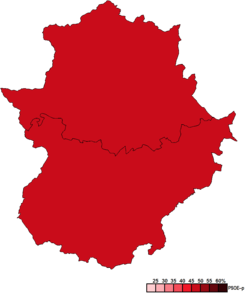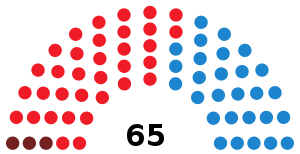1999 Extremaduran regional election
The 1999 Extremaduran regional election was held on Sunday, 13 June 1999, to elect the 5th Assembly of the autonomous community of Extremadura. All 65 seats in the Assembly were up for election. The election was held simultaneously with regional elections in twelve other autonomous communities and local elections all throughout Spain, as well as the 1999 European Parliament election.
| |||||||||||||||||||||||||||||||||||||||||||||
All 65 seats in the Assembly of Extremadura 33 seats needed for a majority | |||||||||||||||||||||||||||||||||||||||||||||
|---|---|---|---|---|---|---|---|---|---|---|---|---|---|---|---|---|---|---|---|---|---|---|---|---|---|---|---|---|---|---|---|---|---|---|---|---|---|---|---|---|---|---|---|---|---|
| Opinion polls | |||||||||||||||||||||||||||||||||||||||||||||
| Registered | 885,753 | ||||||||||||||||||||||||||||||||||||||||||||
| Turnout | 650,527 (73.4%) | ||||||||||||||||||||||||||||||||||||||||||||
| |||||||||||||||||||||||||||||||||||||||||||||
 Constituency results map for the Assembly of Extremadura | |||||||||||||||||||||||||||||||||||||||||||||
| |||||||||||||||||||||||||||||||||||||||||||||
The Spanish Socialist Workers' Party (PSOE) won the election, obtaining 34 seats and 48.5% of the vote. This meant that the party recovered the absolute majority it had lost in the previous election. The opposition People's Party added 1 additional seat to their 27-seat count, but remained almost static in vote terms, gaining 0.5 percentage points albeit losing 1,000 votes from 1995. United Left (IU) lost half of its seats, while the Extremaduran Coalition (CREx-PREx) was left out of the Assembly after breaking up with United Extremadura (EU), which also failed to gain any seats.
The election resulted in Juan Carlos Rodríguez Ibarra being elected President for a fifth term in office.
Overview
Electoral system
The Assembly of Extremadura was the devolved, unicameral legislature of the autonomous community of Extremadura, having legislative power in regional matters as defined by the Spanish Constitution and the Extremaduran Statute of Autonomy, as well as the ability to vote confidence in or withdraw it from a President of the Regional Government.[1] Voting for the Assembly was on the basis of universal suffrage, which comprised all nationals over eighteen, registered in Extremadura and in full enjoyment of their political rights.
The 65 members of the Assembly of Extremadura were elected using the D'Hondt method and a closed list proportional representation, with a threshold of 5 percent of valid votes—which included blank ballots—being applied in each constituency. Parties not reaching the threshold were not taken into consideration for seat distribution. Alternatively, parties failing to reach the threshold in one of the constituencies would also be entitled to enter the seat distribution as long as they ran candidates in both districts and reached 5 percent regionally. Seats were allocated to constituencies, corresponding to the provinces of Badajoz and Cáceres. Each constituency was entitled to an initial minimum of 20 seats, with the remaining 25 allocated among the constituencies in proportion to their populations.[1][2]
The electoral law provided that parties, federations, coalitions and groupings of electors were allowed to present lists of candidates. However, groupings of electors were required to secure the signature of at least 2 percent of the electors registered in the constituency for which they sought election. Electors were barred from signing for more than one list of candidates. Concurrently, parties and federations intending to enter in coalition to take part jointly at an election were required to inform the relevant Electoral Commission within ten days of the election being called.[2][3][4]
Election date
The term of the Assembly of Extremadura expired four years after the date of its previous election. Elections to the Assembly were fixed for the fourth Sunday of May every four years. Legal amendments introduced in 1998 allowed for these to be held together with European Parliament elections, provided that they were scheduled for within a four month-timespan. The previous election was held on 28 May 1995, setting the election date for the Assembly concurrently with a European Parliament election on Sunday, 13 June 1999.[1][2][3][4]
After legal amendments earlier in 1999, the President of the Regional Government was granted the prerogative to dissolve the Assembly of Extremadura and call a snap election, provided that no motion of no confidence was in process, no nationwide election was due and some time requirements were met: namely, that dissolution did not occur either during the first legislative session or within the legislature's last year ahead of its scheduled expiry, nor before one year had elapsed since a previous dissolution under this procedure. In the event of an investiture process failing to elect a regional President within a two-month period from the first ballot, the Assembly was to be automatically dissolved and a fresh election called. Any snap election held as a result of these circumstances would not alter the period to the next ordinary election, with elected deputies merely serving out what remained of their four-year terms.[1][5][6]
Opinion polls
The table below lists voting intention estimates in reverse chronological order, showing the most recent first and using the dates when the survey fieldwork was done, as opposed to the date of publication. Where the fieldwork dates are unknown, the date of publication is given instead. The highest percentage figure in each polling survey is displayed with its background shaded in the leading party's colour. If a tie ensues, this is applied to the figures with the highest percentages. The "Lead" column on the right shows the percentage-point difference between the parties with the highest percentages in a given poll. When available, seat projections are also displayed below the voting estimates in a smaller font. 33 seats were required for an absolute majority in the Assembly of Extremadura.
| Polling firm/Commissioner | Fieldwork date | Sample size | Turnout | CEx | Lead | ||||
|---|---|---|---|---|---|---|---|---|---|
| 1999 regional election | 13 Jun 1999 | N/A | 73.4 | 48.5 34 |
40.0 28 |
6.1 3 |
1.2 0 |
1.7 0 |
8.5 |
| Eco Consulting/ABC[p 1] | 24 May–2 Jun 1999 | ? | ? | 42.3 30/31 |
39.3 28/29 |
11.2 5/6 |
3.1 0 |
1.8 0 |
3.0 |
| Demoscopia/El País[p 2] | 26 May–1 Jun 1999 | ? | 74 | 47.6 32 |
41.7 28 |
8.5 5 |
– | 1.8 0 |
5.9 |
| Sigma Dos/El Mundo[p 3][p 4] | 20–26 May 1999 | 800 | ? | 45.4 30/32 |
41.6 27/30 |
8.0 5 |
2.8 0/1 |
[lower-alpha 1] | 3.8 |
| CIS[p 5][p 6][p 7] | 3–20 May 1999 | 898 | 76.0 | 45.8 32/33 |
40.5 27/28 |
9.3 5 |
– | 2.5 0 |
5.3 |
| 1996 general election | 3 Mar 1996 | N/A | 82.3 | 48.4 33 |
40.3 27 |
8.9 5 |
1.0 0 |
[lower-alpha 1] | 8.1 |
| 1995 regional election | 28 May 1995 | N/A | 78.3 | 43.9 31 |
39.5 27 |
10.5 6 |
3.8 1 |
[lower-alpha 1] | 4.4 |
Results
Overall
 | ||||||
| Parties and coalitions | Popular vote | Seats | ||||
|---|---|---|---|---|---|---|
| Votes | % | ±pp | Total | +/− | ||
| Spanish Socialist Workers' Party–Progressives (PSOE–p) | 313,417 | 48.48 | +4.54 | 34 | +3 | |
| People's Party (PP) | 258,657 | 40.01 | +0.55 | 28 | +1 | |
| United Left–Commitment for Extremadura (IU–CE) | 39,132 | 6.05 | –4.49 | 3 | –3 | |
| United Extremadura (EU) | 10,783 | 1.67 | New | 0 | ±0 | |
| Extremaduran Coalition (CREx–PREx) | 7,437 | 1.15 | –2.67 | 0 | –1 | |
| Independent Socialists of Extremadura (SIEx) | 6,238 | 0.96 | –0.21 | 0 | ±0 | |
| The Greens of Extremadura (LV) | 3,410 | 0.53 | New | 0 | ±0 | |
| Blank ballots | 7,408 | 1.15 | +0.27 | |||
| Total | 646,482 | 65 | ±0 | |||
| Valid votes | 646,482 | 99.38 | +0.04 | |||
| Invalid votes | 4,045 | 0.62 | –0.04 | |||
| Votes cast / turnout | 650,527 | 73.44 | –4.89 | |||
| Abstentions | 235,226 | 26.56 | +4.89 | |||
| Registered voters | 885,753 | |||||
| Sources[7][8] | ||||||
Aftermath
| Investiture Juan Carlos Rodríguez Ibarra (PSOE) | ||
| Ballot → | 15 July 1999 | |
|---|---|---|
| Required majority → | 33 out of 65 | |
34 / 65 | ||
30 / 65 | ||
| Abstentions | 0 / 65 | |
| Absentees | 0 / 65 | |
| Sources[8] | ||
Notes
- Within CEx.
References
- Opinion poll sources
- "El feudo socialista extremeño depende de lU". ABC (in Spanish). 7 June 1999.
- "Rodríguez Ibarra refuerza posiciones". El País (in Spanish). 7 June 1999.
- "Extremadura: Barrero no puede con Ibarra". El Mundo (in Spanish). 31 May 1999.
- "ELECCIONES 13-J /BALANCE DE LAS ENCUESTAS". El Mundo (in Spanish). 6 June 1999.
- "Preelectoral elecciones autonómicas y municipales, 1999. Comunidad Autónoma de Extremadura (Estudio nº 2333. Mayo 1999)". CIS (in Spanish). 4 June 1999.
- "Estudio CIS nº 2333. Ficha técnica" (PDF). CIS (in Spanish). 4 June 1999.
- "Bono e Ibarra repiten y el PSOE recuperará Asturias". La Vanguardia (in Spanish). 5 June 1999.
- Other
- "Statute of Autonomy of Extremadura of 1983". Organic Law No. 1 of 25 February 1983. Official State Gazette (in Spanish). Retrieved 17 March 2017.
- "Assembly of Extremadura Elections Law of 1987". Law No. 2 of 16 March 1987. Official Journal of Extremadura (in Spanish). Retrieved 17 March 2017.
- "General Electoral System Organic Law of 1985". Organic Law No. 5 of 19 June 1985. Official State Gazette (in Spanish). Retrieved 28 December 2016.
- "Representation of the people Institutional Act". www.juntaelectoralcentral.es. Central Electoral Commission. Retrieved 16 June 2017.
- "Statute of Autonomy of Extremadura Reform of 1991". Organic Law No. 5 of 13 March 1991. Official State Gazette (in Spanish). Retrieved 8 April 2017.
- "Statute of Autonomy of Extremadura Reform of 1999". Organic Law No. 12 of 6 May 1999. Official State Gazette (in Spanish). Retrieved 8 April 2017.
- "Assembly of Extremadura election results, 13 June 1999. Badajoz and Cáceres" (PDF). www.juntaelectoralcentral.es (in Spanish). Electoral Commission of Extremadura. 26 June 1999. Retrieved 26 September 2017.
- "Assembly of Extremadura elections since 1983". historiaelectoral.com (in Spanish). Electoral History. Retrieved 26 September 2017.
.jpg)
